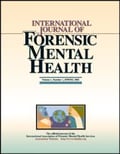Factors predicting forensic in-patient seclusion are unclear, however some key demographic and clinical factors have been identified and need further consideration clinically and in research. This is the bottom line of a recently published article in the International Journal of Forensic Mental Health. Below is a summary of the research and findings as well as a translation of this research into practice.

Featured Article | International Journal of Forensic Mental Health | 2020, Vol. 19, No. 2, 198-213
Factors Associated with Seclusion Use in Forensic Mental Health Settings:
An Integrative Review
Author
Alison Hansen, University of Newcastle; Monash University
Michael Hazelton, University of Newcastle; Hunter Medical Research Institute
Robyn Rosina, University of Newcastle
Kerry Inder, University of Newcastle; Hunter Medical Research Institute
Abstract
Seclusion is a restrictive practice used to protect the person or others from harm, however can result in trauma-related harm. While interventions to reduce seclusion have been successful, use in forensic mental health remains high. This integrative review aims to explore factors associated with the duration and frequency of seclusion in forensic mental health settings and determine sex differences in seclusion use. Results indicate that common factors associated with the use of seclusion in forensic mental health settings are younger age, diagnosis of psychotic disorder or personality disorder, and previous seclusion. Sex differences are inconsistent. Common reasons for initiating seclusion relate to actual violence and threats of violence. There is a lack of contemporary literature and current research has not considered how sex may affect seclusion use. Further research is required to identify specific risk factors for males and females and test timely and appropriate interventions to help reduce seclusion use in forensic mental health settings.
Keywords
Forensic mental health, forensic psychiatry, seclusion, sex
Summary of the Research
“The use of seclusion is a controversial practice, and has been identified as a type of avoidable patient harm. The practice of seclusion infringes on the individual’s rights, can cause physical injury and serious psychological trauma. Despite this, seclusion continues to be used throughout mental health services without evidence for its benefit, or therapeutic value to the individual and their treatment.” (p.198)
“The frequency of seclusion—the number of seclusion events over a period of time—has also increased in forensic mental health settings, whereas the frequency of seclusion in general mental health settings has remained relatively stable.” (p.199)
“Along with the increasing numbers of patients in forensic mental health settings, patients in forensic mental health settings are at risk of long term hospital stays. Further, it has been found that if a patient requires seclusion during the course of their hospital stay, this predicts a longer hospital stay.” (p.199)
“Research conducted in general mental health settings indicates that males, people younger in age and those of Indigenous background are more likely to experience seclusion. As well as those with a diagnosis of schizophrenia, mania or substance abuse.” (p.199)
“Previous literature conducted in forensic mental health settings has suggested that males and females are comparable in relation to their characteristics, mental health histories and presenting problems. However, sex differences have been identified in diagnosis. Women are more frequently diagnosed with major depression with psychosis, and borderline personality disorder, compared to men. This adds context and supports literature that indicates while admitted to forensic mental health settings, women engage in more self-harm compared to men and are involved in frequent incidents of violence.” (p.199)
“The findings suggest that those secluded are typically younger in age and have a diagnosis of a psychotic disorder or personality disorder. Seclusion is commenced for reasons such as a risk of harm to themselves or others. Individuals secluded often experience more than one episode of seclusion and previous seclusion is associated with further seclusion. There is limited data on what factors may influence the duration of seclusion.” (p.208)
Translating Research into Practice
“Clinicians need to be aware that the time from admission and up to a month after admission to hospital is a time of increased risk for seclusion use. Closer monitoring from the time of admission and up to a month for those who are at a higher risk of being secluded may see a reduction in both the frequency and duration of seclusion. Routine screening and risk assessment of patients on admission to identify those at high risk of seclusion, such as younger age, a diagnosis of a psychotic or personality disorder, and previous seclusion, may also help reduce the use of seclusion.” (p.210)
“…identification of patients who present with precipitating factors for seclusion use and factors influencing the duration of a seclusion episode, may assist clinicians in avoiding or reducing the use of seclusion. Risk assessment and subsequent targeted interventions for patients who present with risk factors for seclusion use is important to reduce the likelihood of seclusion use or reduce the duration of a seclusion event. The role of medication in avoiding or reducing the need for and duration of seclusion needs consideration. Finally, recognizing and acknowledging differences and influences that sex may have on clinical presentation and influences may also assist in seclusion reduction.” (p.210)
Other Interesting Tidbits for Researchers and Clinicians
“A greater understanding of specific factors for males and females related to seclusion use, may aid in reducing the use of seclusion. Future research also needs to highlight factors that influence the duration of seclusion. With an understanding of these factors, those who may be a high risk of a longer duration episode can be identified early, in order to reduce or mitigate factors that contribute to a longer seclusion event.” (p.210)
Join the Discussion
As always, please join the discussion below if you have thoughts or comments to add!







